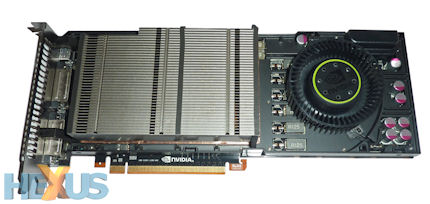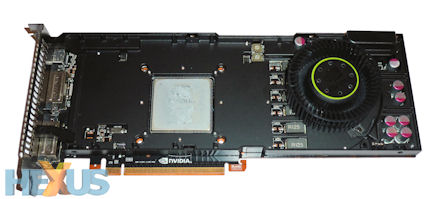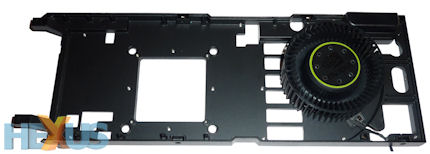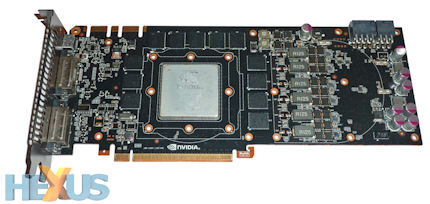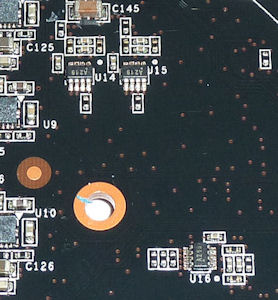The card..more than just a cosmetic change
The GeForce GTX 580 card's toned-down appearance juxtaposes nicely against the heavy-duty look of the GTX 480. Measuring in at the same 10.5in and outfitted with a full-length frame, NVIDIA has had a while to rectify the thermal and noise problems with the top-end Fermi cards.
Outputs remain the same, that is, two dual-DVI and a mini-HDMI v1.4a port that supports Blu-ray 3D. NVIDIA doesn't carry over the bitstreaming-over-HDMI (Dolby True HD and DTS-HD) goodness from GTX 460, however. The nature of the NVIDIA beast also means that you will need two cards to run 3D Vision Surround.
But while the GTX 580 and 480 appear similar, the new GPU's heatsink has been re-designed to push more air into the vent at the back; it's slightly different than the 480's.
Move it around and the card has the same six- and eight-pin power arrangement as found on GTX 480. An easy method of discerning between the two top-line Fermi cards is to take a look at this side and note the lack of extruding heatpipes.
See? No super-hot heatpipes to burn your fingers when removing the card. The back, too, is very similar to a GTX 480's. The SLI fingers enable you - once you have had a positive meeting with your bank manager - to go for three-way SLI rendering.
But remove the frame and differences become apparent. NVIDIA took a lot of flak, rightfully so in our opinion, for the heatsink on the reference GTX 480, which simply wasn't cut out to cool a GPU that could pull over 300W when running FurMark.
NVIDIA improves matters in two ways here. Firstly, the fan is designed to generate a lower pitch when running quickly. It also has a new control mechanism that inhibits rapid changes in rotational speed.
But the main focus is on the cooling. NVIDIA adopts a heatsink with an integrated vapour chamber - much like the ones found on high-end Sapphire Radeon cards - to keep this Fermi quiet(er). Liquid vapour inside the heatsink meets the super-hot plate in contact with the GPU and evaporates, taking heat away with it. The resulting vapour condenses when hitting a cooler surface (surface fins) and then makes its way back to the hotter part of the heatsink in contact with the GPU. This repeatable process is better at removing heat than a slab of copper alone, and it really should have been supplied on the GTX 480 as standard.
Grab a screwdriver and the cooler can be removed in a jiffy. We're then left with the PCB obscured by a plate.
The custom plate won't fit a GTX 480; the components are located in different places. But what we really want to see is what lies underneath.
Slide off the plate and the PCB is revealed. The GPU's 1,536MB framebuffer is contained on 12 chips from Samsung. Take a peek directly to the right of the GPU heatspreader, past the memory, and three tiny chips come into view.
Labelled U14, U15 and U16, these chips control the amount of power-draw available to the card, and they're the reason why FurMark v1.8.2 runs at half-speed on a GTX 580.
SummaryComing in at £399 and representing a 20 per cent price hike over the cheapest GeForce GTX 480 cards the all-new GTX 580 should match that premium with an equivalent gain in performance, if our analysis holds true. The card's revised cooler should make it quieter to boot, and we'll test just this in the benchmark section.
The introduction of the GTX 580 means that incumbent '480's price will probably drop close to £299, to ensure that stock is shifted from inventories. The £399 card will also put pressure on AMD's pricing for the upcoming Radeon HD 6970 part, with the rather large assumption that both performance at similar levels.
NVIDIA's partners will roll with the reference design for the first few weeks. We doubt that we'll see partner-overclocked models before AMD launches the HD 6970, with NVIDIA waiting to see how the GTX 580 compares against AMD's finest single-GPU card.







